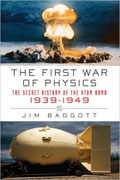The First War of Physics
Jim Baggott
book reviews:
· general fiction
· chick lit/romance
· sci-fi/fantasy
· graphic novels
· nonfiction
· audio books
· author interviews
· children's books @
curledupkids.com
· DVD reviews @
curledupdvd.com
newsletter
win books
buy online
links
home
for authors
& publishers
for reviewers

 |
The First War of Physics: The Secret History of the Atom Bomb, 1939-1949 Jim Baggott Pegasus Paperback 112 pages May 2013 |
|
The topic of the American development of the atomic bomb gives rise to many questions: How did it happen? Why did it happen? Why did the Americans get the bomb first? The First War of Physics
While it was very difficult to get the Roosevelt administration's attention on this potential game-changing technology, progress was finally made via a letter penned by a key scientist but signed off by Albert Einstein. Einstein did not have any involvement with the A-bomb's development, but his signature on this letter finally got the attention of some U.S. government officials. From this point forward, that attention developed into the Manhattan Project--i.e. the development of the atom bomb. Author Jim Baggott delves into the team-building within the U.S., the same research taking place in Germany which had lost some momentum due to the major IQ brain drain and developments in England and Russia. It clearly became a race of desperation since all four countries realized that the first to the finish line would hold a weapon of such immense destructive power that it could single handedly alter the course of the war. Of major interest is the security built around the massive American Manhattan Project and how totally ineffective it proved to be. Time would show that, virtually from its inception, the project had massive security leaks, and its secrecy was about as porous as a piece of cheesecloth. Everything went straight to the Russians. This culminated in the Russians exploding their own nuclear bomb a scant three years after the Americans. Also of major interest was the German's scientific position right after the war. While the Americans, Russians and British all swept into Germany to "capture" many of the German scientists and their research documentation, the German scientists took the position that perhaps they were not the most barbaric of countries. After all, they espoused, it was the Americans who had dropped those heinous devices on unsuspecting and mostly civilian populations. This reviewer thinks it was a case of trying to misdirect blame and responsibility elsewhere. Once the German scientific community had lost a major portion of their top scientists due to their religious purges, they realized they could not compete with U.S. efforts. They took their lack of success and repositioned it as a strategy--a more humane approach for the world's greater good. Perhaps if the Germans had built the bomb first, it would have been used with abandon and the world we know today would not exist. Baggott's examination is a good read but is at times a bit sluggish in its delivery. A lot of names, a lot of technology, but given the time to work your way through it, the carefully-researched details presents a fascinating world of intrigue and high science and events that truly shaped the world we live in today. Originally published on Curled Up With A Good Book at www.curledup.com. © Mick Rosen, 2013 |
|
|
|
 Click here to learn more about this month's sponsor! |
|
| fiction · sf/f · comic books · nonfiction · audio newsletter · free book contest · buy books online review index · links · · authors & publishers reviewers |
|
| site by ELBO Computing Resources, Inc. | |
 As irony would have it, many of the German scientists who made the initial breakthroughs were Jewish
(a quarter of all German physicists were Jews). Due to the religious persecution that was gaining ever greater empowerment in Germany, many of these leading scientists were fleeing Germany for their lives. Not finding safe haven in other parts of Europe, many came to the U.S. By the early
1940s, many of these high-level atomic scientists were making it known to the State Department and the War Department that the Germans were well advanced in weaponizing this nuclear research.
As irony would have it, many of the German scientists who made the initial breakthroughs were Jewish
(a quarter of all German physicists were Jews). Due to the religious persecution that was gaining ever greater empowerment in Germany, many of these leading scientists were fleeing Germany for their lives. Not finding safe haven in other parts of Europe, many came to the U.S. By the early
1940s, many of these high-level atomic scientists were making it known to the State Department and the War Department that the Germans were well advanced in weaponizing this nuclear research.